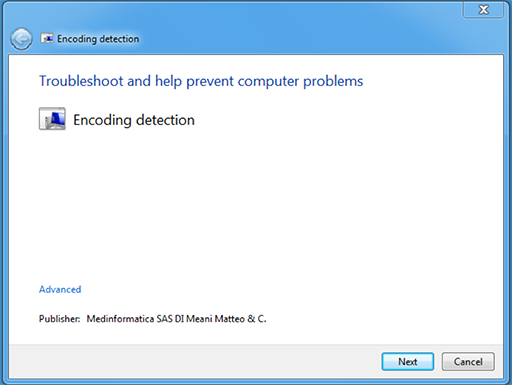Windows Troubleshooting Platform 'is serving malware'
Troubleshooting service used as a pathway to con victims into downloading malware


Hackers are abusing Windows Troubleshooting Platform (WTP) to trick users into downloading malware onto their computers.
WTP is a legitimate feature in Windows, intended for troubleshooting problems. However, researchers at Proofpoint have found a social engineering attack that uses this normally helpful service as a vector for infection.
In a blog post, the researchers said: "This attack is particularly effective since execution of WTP is not accompanied by a security warning and users have been conditioned to run the troubleshooter when it appears in Windows. In this case, though, running the troubleshooter leads to the installation of LatentBot, a well-documented modular bot used for surveillance, information stealing, and remote access."
The scam runs like this: The target victim receives an email with a file attachment that, when downloaded and opened, looks as if there is an issue with the computer's font set. The user is prompted to "double-click to auto detect charset", which, if followed, opens a real embedded, digitally signed DIAGCAB file - the extension for a Troubleshooting pack.
Once opened, this displays what Proofpoint calls a "convincingly realistic" download wizard (see below). If the user clicks "next" in this window, the malware payload is then downloaded and executed on the computer.

"This method of malware execution bypasses observation by many existing sandbox products because the malicious activity is carried out outside of the msdt.exe binary loading the .diagcab file," said Proofpoint.
"This continues the trend of malware authors seeking new sandbox evasion methods via COM-based non-standard execution flow; previous examples of these methods are WMI, Office Interoperability, Background Intelligent Transfer Service, and the Task Scheduler."
Get the ITPro daily newsletter
Sign up today and you will receive a free copy of our Future Focus 2025 report - the leading guidance on AI, cybersecurity and other IT challenges as per 700+ senior executives
The method could, the researchers said, "fool even experienced users", due to how convincing it is and the fact it evades detection by many sandboxing techniques.
IT Pro has approached Microsoft for comment, but had received none at the time of publication.

Jane McCallion is Managing Editor of ITPro and ChannelPro, specializing in data centers, enterprise IT infrastructure, and cybersecurity. Before becoming Managing Editor, she held the role of Deputy Editor and, prior to that, Features Editor, managing a pool of freelance and internal writers, while continuing to specialize in enterprise IT infrastructure, and business strategy.
Prior to joining ITPro, Jane was a freelance business journalist writing as both Jane McCallion and Jane Bordenave for titles such as European CEO, World Finance, and Business Excellence Magazine.
-
 Bigger salaries, more burnout: Is the CISO role in crisis?
Bigger salaries, more burnout: Is the CISO role in crisis?In-depth CISOs are more stressed than ever before – but why is this and what can be done?
By Kate O'Flaherty Published
-
 Cheap cyber crime kits can be bought on the dark web for less than $25
Cheap cyber crime kits can be bought on the dark web for less than $25News Research from NordVPN shows phishing kits are now widely available on the dark web and via messaging apps like Telegram, and are often selling for less than $25.
By Emma Woollacott Published
-

 Netgear ReadyNAS RN426 review
Netgear ReadyNAS RN426 reviewReviews A good value 6-bay NAS appliance that teams up unbeatable data protection features with an impressive performance
By Dave Mitchell Published
-
 Five simple ways SMBs can fend off hackers and cyber attacks
Five simple ways SMBs can fend off hackers and cyber attacksNews National Cyber Security Centre gives out infosec advice for small businesses
By Abigail Beall Published
-

 Kerio Control NG300W review
Kerio Control NG300W reviewReviews Lacking anti-spam but Kerio’s wireless-enabled NG300W appliance scores highly for value and performance
By Dave Mitchell Published
-
 Over a million corporate file-shares are exposed to attacks
Over a million corporate file-shares are exposed to attacksNews Vulnerable SMB ports could lead to a second WannaCry outbreak, say experts
By Adam Shepherd Published
-
 Symantec snaps up LifeLock for $2.3 billion
Symantec snaps up LifeLock for $2.3 billionNews Security company acquires identity theft protection firm
By Rene Millman Published
-
 Legal experts predict 600% surge in data protection disputes
Legal experts predict 600% surge in data protection disputesNews Disputes could rocket by six times in next five years
By Rene Millman Published
-
 AdultFriendFinder hack 'exposes 412 million users'
AdultFriendFinder hack 'exposes 412 million users'News Account details were reportedly stored in plaintext
By Jane McCallion Published
-
 Experts say UK must keep pace with cyber threats
Experts say UK must keep pace with cyber threatsIn-depth Industry welcomes £1.9bn investment, but highlights skills shortage
By Rene Millman Published